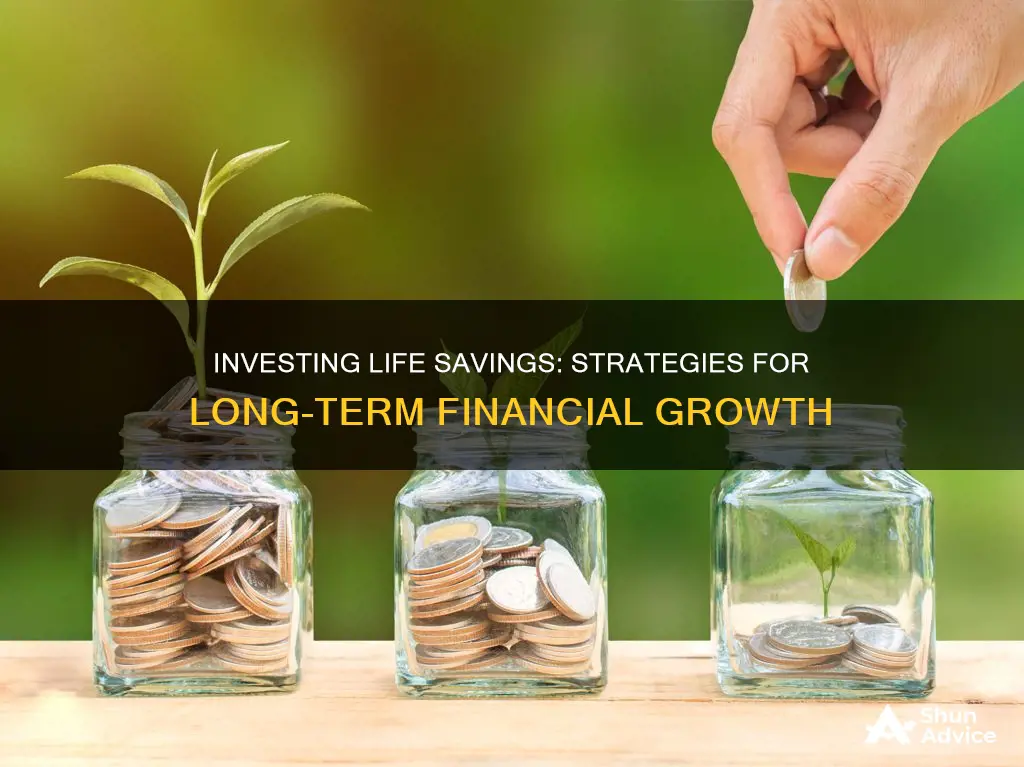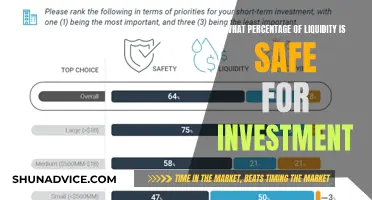
Investing your life savings can be a daunting task, but it is a great way to build wealth over time. Before investing, it is important to assess your financial situation, determine your budget, and understand your risk tolerance. There are a variety of investment options available, from low-risk savings accounts to higher-risk stocks and mutual funds. By considering your short-term and long-term goals, you can decide which investment options align with your financial objectives. It is also crucial to consult with a qualified professional who can provide guidance based on your specific circumstances.
| Characteristics | Values |
|---|---|
| Savings account type | High-yield savings account |
| Investment type | Certificates of Deposit (CDs), Money Market Funds, Treasury Bills and Notes, Mutual Funds, Stocks, Bonds, Index Funds, ETFs, Mutual Funds, REITs |
| Risk | Low, Medium, High |
| Returns | Low, Medium, High |
| Time horizon | Short-term, Medium-term, Long-term |
| Investment style | Active, Passive |
| Budget | $100, $1000 |
| Risk tolerance | Low, Medium, High |
| Goals | Short-term, Medium-term, Long-term |
What You'll Learn

Understanding your risk tolerance
Time Horizon:
The time horizon refers to when you need the money. If you need funds in the short term, for example, for an upcoming expense or financial goal within the next few years, you may want to choose less risky investments. On the other hand, if you have a longer time horizon, such as saving for retirement, you may be comfortable taking on more risk for potentially higher returns.
Investment Knowledge and Involvement:
Your knowledge of investing and the amount of time you want to dedicate to managing your investments are important considerations. If you are well-versed in investing and have the time to research and monitor your investments actively, you may feel more comfortable taking on higher-risk investments. On the other hand, if you are a beginner or prefer a more passive approach, you may opt for lower-risk options or work with a financial advisor or robo-advisor.
Investment Options:
Different investment options come with varying levels of risk. For example, high-yield savings accounts, certificates of deposit (CDs), and government bonds are generally considered lower-risk options. In contrast, stock investments, particularly individual stocks, and certain types of bonds can be riskier but offer the potential for higher returns. Assess your comfort level with the level of risk associated with each investment option.
Financial Situation and Goals:
Your financial situation and goals will also play a role in determining your risk tolerance. If you have a stable financial situation, a high risk tolerance, and are investing for the long term, you may be comfortable allocating a larger portion of your portfolio to riskier investments. On the other hand, if you are approaching retirement or have specific short-term financial goals, you may prefer a more conservative approach to reduce the potential for losses.
Personal Comfort and Psychology:
Risk tolerance is not just about financial factors; it also involves your personal comfort level with risk. Some people are naturally more comfortable taking on higher risks, while others prefer a more conservative approach. It's essential to be honest with yourself about your ability to handle market volatility and the potential for losses.
By considering these factors, you can gain a better understanding of your risk tolerance, which will help guide your investment decisions and ensure they align with your financial goals and comfort level. Remember, investing involves risk, and it's important to carefully consider your options before committing your life savings.
Maximizing UK Savings: Investment Strategies for Beginners
You may want to see also

Choosing between active and passive investing
Passive investing is a long-term, low-cost strategy that aims to match the market's performance rather than outperform it. It involves buying and holding a diverse range of assets, such as stocks, bonds, and index funds, without trying to time the market. On the other hand, active investing involves making investment decisions based on the investor's or fund manager's independent assessment of the market and their goal to "beat the market".
Passive investing is generally more popular among individual investors, especially beginners, as it offers diversification, lower fees, and reduced risk compared to active investing. Passive funds tend to be more transparent, and the buy-and-hold strategy can lead to greater returns over time. However, passive funds may offer lower returns and can be more limiting during market downturns.
Active investing, on the other hand, provides increased flexibility and the potential for higher returns. Active fund managers can adapt their strategies to real-time market conditions and implement various trading strategies. Additionally, active investing offers more tax-loss harvesting opportunities and better risk management. Nevertheless, active investing often leads to lower long-term returns and higher fees due to frequent trading and specialised expertise.
Both strategies have their advantages and disadvantages, and the best approach depends on your financial goals, risk tolerance, and expertise. Passive investing is generally suitable for long-term growth, while active investing may be preferred for taking advantage of short-term market opportunities. Some investors also choose to combine both strategies by allocating their investments across passive and active funds or different types of assets.
When deciding between active and passive investing, it's essential to consider factors such as your risk tolerance, investment horizon, costs, and the level of involvement you want in managing your investments.
Yotta Savings: A Smart Investment Strategy for Your Money
You may want to see also

Building an emergency fund
The general rule of thumb is to save enough to cover three to six months' worth of expenses. This amount can vary depending on your situation and the types of unexpected costs you may incur. It is a good idea to consider your most common unexpected expenses and how much they cost to help set a savings goal. Even if you can only save a small amount, it can still provide some financial security.
Strategies for building an emergency fund
- Create a savings habit: Set a specific goal for your emergency fund and make consistent contributions. Regularly monitor your progress and celebrate your successes.
- Manage your cash flow: Keep track of when your income is coming in and when your expenses are going out. Adjust your spending and savings accordingly.
- Take advantage of one-time opportunities: Save all or a portion of any large sums of money you receive, such as tax refunds or cash gifts.
- Make your saving automatic: Set up automatic recurring transfers from your checking account to your savings account. You can decide on the amount and frequency of transfers.
- Save through work: If you receive your paycheck through direct deposit, ask your employer if they can divide it between your checking and savings accounts.
Where to keep your emergency fund
You can keep your emergency fund in a bank or credit union account, generally considered one of the safest options. Other options include a prepaid card, which is not connected to a bank or credit union, or keeping cash on hand at home or with a trusted family member or friend.
When to use your emergency fund
Set guidelines for what constitutes an emergency or unplanned expense, and try to be consistent. Remember that your emergency fund is there to help you avoid relying on credit cards or loans, which can lead to debt. Don't be afraid to use your emergency fund when you need it, and work on building it back up afterward.
Invest Wisely: A Guide to Savings in Australia
You may want to see also

Investing in stocks
Set Clear Investment Goals:
Be specific about your financial objectives. For example, instead of a vague goal like "saving for retirement," aim for a target like "accumulating $500,000 in my retirement fund by age 50." Clear goals will guide your investment decisions and help you stay focused.
Determine How Much You Can Afford to Invest:
This step requires a realistic assessment of your finances. Review your income sources, establish an emergency fund, pay off high-interest debts, and create a budget to decide how much money you can comfortably invest in stocks.
Determine Your Risk Tolerance and Investing Style:
Understanding your risk tolerance is crucial. Are you willing to accept higher risks for potentially greater returns, or do you prefer stability? Your risk tolerance will depend on your investment timeline and financial cushion.
Choose an Investment Account:
There are different types of accounts to choose from, including regular brokerage accounts, retirement accounts, and managed accounts. Consider the tax implications of each account type and evaluate the fees, commissions, and minimums associated with the account.
Fund Your Stock Account:
You can fund your stock account through a bank transfer, check deposit, or transfer from another brokerage. Consider setting up automatic contributions to invest a fixed amount regularly, regardless of market conditions.
Pick Your Stocks:
Look for stability, a strong track record, and the potential for steady growth when choosing stocks. Some types of stocks to consider are blue-chip stocks (shares of large, well-established companies), dividend stocks (companies that pay regular dividends), growth stocks (with potential for outsized growth), and defensive stocks (industries that perform well during economic downturns).
Learn, Monitor, and Review:
Stay informed about the global economy, industry trends, and the companies you invest in. Use stock simulators to practice trading, and learn about diversification to reduce risk and improve potential returns. Regularly review your investment goals and adjust your portfolio as needed.
Remember, investing in stocks carries the risk of losing money if a company's share price falls. It's important to do your research and understand the potential risks and rewards before investing your life savings.
Savings Investment Strategies: Accessibility and Growth
You may want to see also

Investing in bonds
Bonds are a form of investment that can be issued by companies or governments. They are a type of loan from the buyer to the issuer, and they generally pay a fixed interest rate. The market value of a bond changes over time as its attractiveness to potential buyers fluctuates. Bonds that are more likely to be paid on time tend to offer lower interest rates. Similarly, bonds with shorter maturities (length until full repayment) tend to have lower interest rates.
There are several types of bonds:
Corporate Bonds
Issued by companies, these bonds tend to offer higher interest rates than other types. However, the companies that issue them are more likely to default than government entities.
Municipal Bonds
Municipal bonds, also called muni bonds, are issued by states, cities, and local government entities to finance public projects or offer public services. For example, a city might issue muni bonds to fund the construction of a new bridge or the redevelopment of a neighbourhood park.
Treasury Bonds
Treasury bonds, or T-bonds, are issued by the US government. Because there is no default risk, they don't need to offer the same high interest rates as corporate bonds.
Unlike stocks, most bonds are not publicly traded. Instead, they are traded over the counter, which means you must use a broker. An exception to this is treasury bonds, which can be bought directly from the US government without a middleman.
Pros of Investing in Bonds
- Safety: Bonds are a relatively safe investment as their values don't fluctuate as much as stock prices.
- Income: Bonds offer a predictable income stream, paying a fixed amount of interest, usually twice a year.
- Community: When you invest in a municipal bond, you might help improve a local school system, build a hospital, or develop a public garden.
- Diversification: Bonds bring diversification to your portfolio. While stocks have historically outperformed bonds, having a mix of both reduces your financial risk.
Cons of Investing in Bonds
- Less Cash: Bonds require you to lock your money away for extended periods.
- Interest Rate Risk: Bonds are relatively long-term investments, so you face the risk of interest rate changes. If interest rates increase after you buy a bond, your bond will drop in value.
- Issuer Default: Although uncommon, there is a risk that the issuer could default on its obligations, causing you to lose out on interest payments or the repayment of your principal.
- Transparency: There is less transparency in the bond market than in the stock market, so it can be challenging to determine whether you're getting a fair price.
- Smaller Returns: The return on investment from bonds is typically lower than that of stocks.
How to Invest in Bonds
You can buy bonds from the bond market via a broker, through an ETF, or directly from the US government.
Buying and Holding to Maturity
One strategy for investing in bonds is to buy and hold them until they mature, collecting interest payments along the way.
Selling Early
Another strategy is to sell bonds early at a higher price than you paid, profiting from the difference.
Bond Funds
Bond funds pool money from multiple investors for a fund manager to handle, usually by purchasing a variety of individual bonds. Investing in bond funds is considered even safer than owning individual bonds.
What to Watch for When Buying Bonds
There are two ways to earn income when investing in bonds:
- Buy and hold the bond until it matures, then collect the principal and interest.
- Sell the bond before maturity at a higher price than you paid.
When evaluating bonds, it's essential to consider the borrower's ability to pay, the interest rate, and the bond's term. It's also important to check the bond's rating to understand its financial health.
Social Security Investment Strategies: Maximizing Your Savings
You may want to see also
Frequently asked questions
There are several types of savings accounts, including high-yield savings accounts, money market deposit accounts, and certificates of deposit (CDs). Each has its own advantages and disadvantages in terms of interest rates, accessibility, and risk.
It's important to understand your risk tolerance before investing. Ask yourself how much financial risk you are willing to take. Generally, younger people can invest more aggressively, while older people should be more conservative.
Beginners can start by opening a brokerage account and investing in passive investments like index funds and mutual funds. Another option is to use a robo-advisor, which is an automated platform that creates a personalised portfolio based on your risk tolerance and financial goals.







